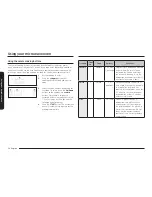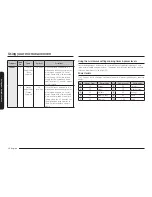
26 English
C
ookw
ar
e g
uide
Cookware guide
Not recommended
•
Glass jars and bottles —
Regular glass is too thin to be used in a microwave
and can shatter.
•
Paper bags —
These are a fire hazard, except for popcorn bags that are
designed for microwave use.
•
Styrofoam plates and cups —
These can melt and leave an unhealthy residue
on food.
•
Plastic storage and food containers —
Containers such as margarine tubs can
melt in the microwave.
Testing utensils
If you are not sure whether a dish is microwave-safe or not, you can perform this
test:
1.
Fill a 1 cup glass measuring cup with
water and put it inside your oven, next
to the dish you want to test.
2.
Set the microwave to 1 minute using
the
numeric
buttons, and then press the
START
button. This will heat the glass
and dish for one minute at High power.
When the microwave stops, the water
should be warm and the dish you are
testing should be cool.
If the dish is warm, then it is absorbing
microwave energy and is not acceptable for
use in the microwave.
Cookware guide
To cook food in your microwave oven, microwaves must be able to penetrate the
food without being reflected or absorbed by the cookware holding the food.
Consequently, it is important to choose cookware that both allows microwaves to
penetrate food and is microwave-safe.
The following lists contain various types of cookware and indicate if and how the
cookware should be used in a microwave oven.
Recommended cooking utensils
•
Glass and glass-ceramic bowls and dishes —
Use for heating or cooking.
•
Microwavable plastic wrap —
Use to cover. Leave a small opening for steam to
escape and avoid placing it directly on the food.
•
Wax paper —
Use as a cover to prevent spattering.
•
Paper towels and napkins —
Use for short-term heating and covering. They
absorb excess moisture and prevent spattering. Do not use recycled paper
towels, which may contain metal and can catch fire.
•
Paper plates and cups —
Use for short-term heating at low temperatures. Do
not use recycled paper, which may contain metal and can catch fire.
•
Thermometers —
Use only those labeled “Microwave Safe” and follow all
directions. Check the food in several places. Conventional thermometers may
be used once the food has been removed from the oven.
Limited use items
•
Aluminum foil —
Use narrow strips of foil to prevent overcooking of exposed
areas. Using too much foil can damage your oven, so be careful.
•
Ceramic, porcelain, and stoneware —
Use these if they are labeled “Microwave
Safe”. If they are not labeled, test them to make sure they can be used safely.
Never use dishes with metallic trim.
•
Plastic —
Use only if labeled “Microwave Safe”. Other plastics can melt.
•
Straw, wicker, and wood —
Use only for short-term heating, as they are
flammable.
Содержание ME21M706BA Series
Страница 1: ...Microwave Oven User manual ME21M706BA ...
Страница 41: ...English 41 Memo ...
Страница 42: ...42 English Memo ...
Страница 43: ...English 43 Memo ...
Страница 45: ...Horno de microondas Manual del usuario ME21M706BA ...
Страница 85: ...Español 41 Notas ...
Страница 86: ...42 Español Notas ...
Страница 87: ...Español 43 Notas ...
Страница 89: ...Four à micro ondes Manuel d utilisation ME21M706BA ...
Страница 129: ...Français 41 Notes ...
Страница 130: ...42 Français Notes ...
Страница 131: ...Français 43 Notes ...
















































